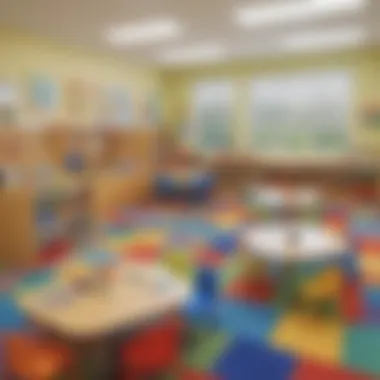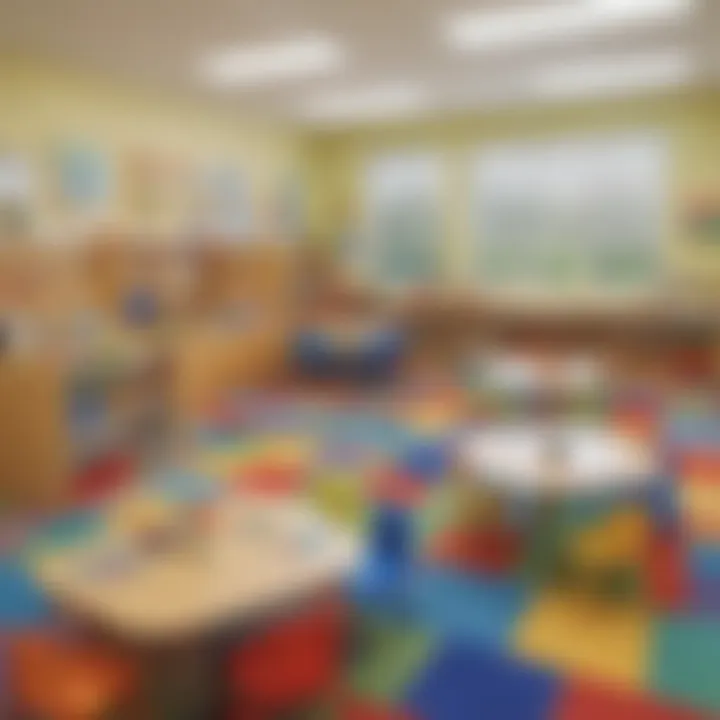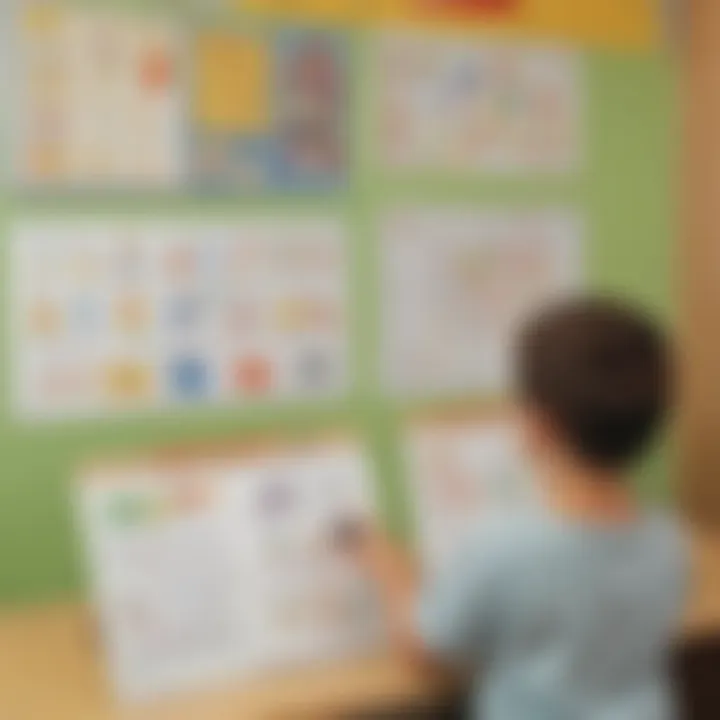Mastering Kindergarten Classroom Management for Success


Intro
In kindergarten, classroom management plays a crucial role in ensuring young learners thrive. Establishing a structured atmosphere that promotes positive behavior and encourages engagement benefits students and teachers alike. Early childhood education has its specific challenges, with educators needing to address diverse needs and dynamics. This guide seeks to explore various methodologies that align with these needs and provide educators with essential strategies, ultimately fostering a conducive learning environment for children.
Creative Activities
Creative activities are essential in kindergarten classrooms. They spark imagination and development. Simple crafts can encourage fine motor skills and enhance cognitive abilities.
Craft Ideas
- Paper Plate Animals: Use paper plates for children to create various animals. Provide colors and basic instructions to guide their creativity.
- Painting with Nature: Collect leaves and flowers, and let children paint over them to create unique artworks.
Step-by-Step Guides
For a successful Paper Plate Animal project:
- Gather supplies - paper plates, colors, scissors, and glue.
- Show example animals.
- Let children choose an animal and sketch it on their plate using colors.
- Encourage them to cut out features and glue them on.
Educational Value
Engaging in creative activities promotes not just artistic expression. Children also learn critical thinking and problem-solving skills. Craft activities enhance focus and improve hand-eye coordination.
Fun Quizzes
Quizzes can be integral to feedback and provides a fun way to reinforce learning in young students. They confirm understanding and retention of concepts introduced in class.
Quiz Topics
Various subject areas can be covered in quizzes, such as colors, shapes, numbers, and animals. Aligning quizzes with lesson plans allows it to reinforce concepts effectively.
Question Types
Quizzes should feature a diversity of question styles:
- Multiple choice
- Fill-in-the-blank
- Picture-based questions
Knowledge Reinforcement
Such varied content keeps the students engaged and prompts them to think criticaly. This blend of assessment and play ensures that learning remains fun and well-received by children.
Fact-Based Articles
Integrating fact-based articles can enhance the learning process further. They serve as reliable resources and provide accurate information at an accessible level separate from conventional textbooks.
Topics
A range of articles could cover food, animals, seasons, or important events, enriching the classroom topic discussions with factual bases.
Engaging Content
If they are presented in an engaging manner, children can absorb the information easily. Articles that break down complex ideas are particularly beneficial to young audiences.
Understanding Kindergarten Classroom Management
Classroom management is an essential aspect of education, particularly in a kindergarten setting. It refers to the approaches and techniques that teachers use to create and maintain a productive learning environment. Young children require a structured, nurturing setting to thrive. Thus, effective kindergarten classroom management goes beyond enforcing rules. It establishes a foundation for learning and growing. Knowing how to manage a classroom successfully boosts both teacher confidence and student achievement.
Defining Classroom Management
Classroom management encompasses a variety of components, including strategies for engagement, discipline techniques, and methods to foster positive relationships. It lays out clear expectations while ensuring that students understand the norms within their learning environment. Important aspects to note include:
- Setting clear rules and routines.
- Implementing strategies tailored to young learners.
- Cultivating a positive teacher-student dynamic.
Ultimately, classroom management serves to streamline behaviors and facilitate effective instruction.
Significance of Management Techniques
The significance of well-planned management techniques cannot be overstated. Such techniques help educators handle disruptions and create an environment that supports instruction. Structured classroom management yields several benefits:
- Enhanced student engagement, as clear routines help children know what to expect.
- Prevention of behavioral issues, which allows teachers to spend more time on learning instead of discipline.
- Improved relationships, as open communication promotes trust between tamers and students.
Establishing effective techniques leads to a more productive learning atmosphere. This strategic groundwork is crucial for students to reach their full potential.
The Role of the Teacher in Classroom Management
Effective classroom management hinges greatly on the teacher's role. Teachers serve as guides and leaders in creating an environment where young learners feel safe, valued, and engaged. Their influence extends beyond instruction and into the realm of shaping behavior, building trust, and fostering a love for learning. The ability to maintain discipline while encouraging positive actions is central to establishing an effective kindergarten setting.
Teachers model the behaviors they wish to see in their students. They set expectations for conduct and evaluate their effectiveness. As trusted figures in the classroom, educators motivate students and illustrate essential social skills. Thus, a teacher’s approach can determine the overall atmosphere and success of the learning environment.
Establishing Authority and Trust
A teacher must establish authority without resorting to harsh measures. This authority stems from consistency, fairness, and confidence. To gain students' respect, a teachers can prevent potential issues and intrusion through clear direction on behaviors and routines that are expected in the classroom. When students understand rules, they're more likely to choose to comply.
Trust is equally pivotal. Developing strong relationships is crucial, as students learn best when they feel secure. An effective teacher demonstrates genuine care. One way to gain trust is through open communication. Teachers should encourage students to share their thoughts and concerns. Visitors can show them that their voices are valued. This strengthens connections and helps in forming a trustworthy atmosphere for learning.
“The most wonderful thing a teacher can do is to engage a student's heart as well as their mind.”
Creating a Supportive Atmosphere
A supportive atmosphere in the kindergarten classroom allows young learners to thrive. This space encourages freedom of expression while emphasizing respect for one another. There are several strategies to create such an atmosphere.
- Promote Positivity: Teachers should recognize and celebrate class achievements. Simple things like verbal praise or a small reward can heighten motivation.
- Encourage Collaboration: Inviting students to participate in group work fosters a sense of community. When children feel connected to one another, they are more likely to support each other in managing behaviors.
- Provide Clear Instructions: Young students often require extra guidance. Being explicit about tasks and transitioning between activities reduces anxiety and confusion. A teacher's calm tone aids in smoothing operations as well.


Overall, one's efforts to establish a supportive and nurturing space directly correlates to student engagement and behavior management. As emotions and socialovers dominate this age group, positive interactions enable children to develop essential skills and behaviors.
Developing Classroom Rules and Routines
Creating effective classroom rules and routines is fundamental in kindergarten education. It helps establish boundaries for students. When rules are simple, clear, and consistently enforced, students understand what is expected of them. This clarity allows for easy navigation of classroom behavior and creates an environment where young learners can thrive. Students are often more willing to adhere to rules they had a hand in creating. Engagement in rule-making can foster a sense of ownership, leading to improved adherence.
Collaborating with Students
Collaboration with students in developing classroom rules is a beneficial strategy. When children are involved, they tend to take the rules more seriously. This participation encourages ownership of the classroom environment. Teachers can start by having discussions with children about what makes a good classroom. Here are some key considerations for collaboration:
- Create a Conversation: Engage students in an open dialogue. Ask questions like, "What behaviors make you feel safe?" or "How can we help each other learn?"
- Brainstorm Together: Use group activities to gather ideas. Recording suggestions on a whiteboard can include everyone’s thoughts.
- Vote on the Best Ideas: Display the collected suggestions and allow children to vote on their favorite rules. This promotes democratic involvement.
By having their input, students are more likely to comply with the rules since they feel valued and recognized.
Visual Aids for Rules
Visual aids enhance understanding and retention of classroom rules. Young children respond well to visual stimuli. Using images can help them remember the rules better. Some effective types of visual aids include:
- Posters: Create colorful posters highlighting each rule. Place them prominently around the classroom.
- Illustrations: Simple drawings can help clarify rules. A picture of a child raising a hand can depict respectful behavior during instructions.
- Today’s Agenda Board: A visual schedule provides clarity on daily activities. It helps children anticipate transitions and cue expectations throughout the day.
The goal is to provide consistent reminders in a format that resonates with young learners. Through both collaboration and structured visuals, teachers can lay the foundation for effective management in their classrooms.
Establishing a Productive Learning Environment
Establishing a productive learning environment is crucial in a kindergarten classroom. Young learners thrive in settings where they feel safe, supported, and stimulated. A well-organized and engaging space can enhance their learning experiences, promote positive behavior, and encourage exploration. Educators must consider various aspects when creating this conducive environment, focusing on physical setup, emotional tone, and resource accessibility.
Organizing Classroom Space
When organizing the classroom space, a clear arrangement is vital. The layout should allow easy movement for children while reducing congestion and distractions. Classrooms can be divided into specific areas for diverse activities, such as reading, art, and playtime. Each zone can serve particular learning objectives, helping to maximize instructional time.
Key considerations in organizing the classroom include:
- Visibility: Teachers should maintain sight lines throughout the room so that they can easily monitor students.
- Accessibility: All learning materials should be within reach for children to promote independence.
- Flexibility: The arrangement can be modified for various lessons, allowing for both individual and group work.
Investing time in the organization signifies a deep commitment to student learning. Such a person values the foundational structure essential for fostering growth.
Creating Learning Centers
Creating learning centers is another essential element of a productive classroom. These centers are designated spots where students engage with materials geared towards specific skills or subjects. Learning centers offer an interactive approach that tailors activities to various learning styles.
Benefits of learning centers include:
- Encouragement of collaborative learning: Students often work together, reinforcing social skills alongside academic growth.
- Hands-on experience: Center activities often involve manipulatives or interactive elements, deepening understanding through practice.
- Differentiated instruction: Activities can be designed according to student levels, benefiting advanced learners through challenges and supporting those who need reinforcement.
A classroom filled with well-planned learning centers becomes a dynamic and vibrant space. Such an environment invites curiosity and exploration, both paramount to the kindergarten experience.
“The learning environment either excites the desire to learn or quenches it altogether.”
Techniques for Positive Reinforcement
Positive reinforcement is a key strategy in effective kindergarten classroom management. This technique encourages desired behavior in students by providing rewards or recognition when they display those behaviors. Its significance lies in fostering a positive atmosphere in which young learners feel motivated and valued.
Positive reinforcement works because it builds confidence. When children recognized promote a particular behavior, they are more likely to repeat it. This can create a cycle of positive actions in the classroom. Not only does it boost their self-esteem, but it also supports a more engaged learning environment. Educators need to consider various positive reinforcement methods tailored to their student's needs.
Incorporating Rewards Systems
Incorporating rewards systems in the classroom can be a powerful tool. These systems can be simple or complex, depending on the class’s needs. For instance, teachers might implement a sticker chart, where students earn stickers for displaying good behavior, completing assignments, or helping classmates. At certain milestones, they can exchange their stickers for a small reward, such as extra playtime or a little prize. This tangible system helps translate achievements into desirable outcomes.
- Examples of Rewards Systems:
- Sticker charts
- Class points system
- Token economy
Using rewards systems requires thoughtful planning. Teachers should ensure rewards are appropriate and enticing to keep students engaged. Subsequently, they need to be consistent in applying the rewards to maintain the system's integrity.
Praise for Efforts and Achievements
Praise plays a significant role in positive reinforcement as well. When educators take the time to acknowledge each child's efforts and achievements, they feel valued. Recognition can be verbal, or it can take the form of certificates displayed in the classroom or positive notes sent home to parents.
Effective praise is specific. Instead of general comments like, “Good job,” teachers should say, “I appreciate how you helped your friend with that activity.” This specific feedback helps children understand what they did right.
- Benefits of Using Praise:
- Strengthens personal motivation
- Encourages continued effort
- Fosters connections among students
By integrating a well-structured approach to both rewards systems and verbal praise, teachers create a nurturing environment. The underlying goal is to encourage not just compliance but also to promote the child's natural curiosity and motivation to learn.
Remember: Positive reinforcement is not just about rewards but about engendering a mindset of success and collaboration among young learners. Every small step matters in their learning journey.
Managing Student Behavior
Managing student behavior is a fundamental aspect of classroom management in kindergarten settings. Effective strategies tailored to the unique developmental stages of young children can create a harmonious learning environment. This section aims to delve into how understanding behavior management can positively affect student outcomes. The right approach aids in building a supportive atmosphere that fosters engagement and retention of vital skills.
Identifying Triggers for Disruptions
Recognizing triggers that lead to disruptions is the first step in effective behavior management. Distractions in the classroom can arise from various sources, such as noise levels, classroom layout, or even peer interactions. By identifying these triggers, educators can target interventions effectively.
Some common disruptors include:
- Overstimulation: Bright lights, loud noises, or crowded settings may overwhelm young learners.
- Unclear Expectations: If rules or routines are not clearly communicated, children can become confused and act out.
- Social Dynamics: Conflicts or difficulties in peer relationships often emerge in kindergarten and can lead to interruptions in learning.
By being vigilant and observant, teachers can take note of specific situations in which behaviors change. Keeping track of these moments will help when looking to adjust routines or practices accordingly.


Implementing Behavior Interventions
Once triggers have been identified, teachers can move to the implementation of behavior interventions. These structured interventions are tools designed to modify and improve student behavior. An effective behavior intervention can range from individual plans to classroom-wide systems. The goal is to support children in developing self-regulation skills, essential for their academic and social development.
Some strategies for behavior interventions include:
- Positive Reinforcement: This involves acknowledging good behavior through verbal praise or reward systems. Help children recognize what appropriate behavior looks like, reinforcing it positively.
- Clear Consequences: Establish a set of clear, fair consequences for disruptive behavior. Children need to understand the results of their actions.
- Behavior Reflection: Encourage self-reflection through discussions or journals about their actions and feelings. This helps them internalize lessons in a developmentally appropriate way.
Teachers should assess the effectiveness of these interventions continuously. Adjustments may be needed as students grow and change. By fostering a positive environment through effective behavior management strategies, teachers not only minimize disruption but also empower students to take control of their learning journey.
“Managing behavior effectively can transform the classroom into a space of learning, where every child feels valued and necessary.”
Engaging Students in the Learning Process
Engaging students in the learning process is at the heart of effective kindergarten education. When children are actively involved, they learn more and retain information better. It's essential for educators to create an environment where each child’s input is valued. This engagement fosters a love for learning and encourages initiative. Teachers can achieve this through various strategies that establish meaningful connections with students.
Utilizing Interactive Activities
Interactive activities offer a unique pathway for students to engage with the curriculum. These activities can range from hands-on projects to group games that require teamwork and creativity. By incorporating elements that children can physically manipulate or respond to, teachers increase student interest and participation.
Some techniques include:
- Arts and Crafts: Children express creativity while learning concepts.
- Science Experiments: Simple experiments can spark curiosity and excitement.
- Role-Playing Games: Enables students to embody characters, deepening understanding.
These activities do not merely provide fun; they create a framework where learning is intertwined with play. Such experiences allow children to explore concepts at their own pace while developing essential interpersonal skills like sharing, collaboration, and communication.
Encouraging Student Participation
Fostering participation is crucial for cognitive growth. Encouraging interaction among students helps them voice their thoughts, ask questions, and contribute to discussions. This active involvement nurtures a sense of belonging in the classroom, which is vital during the early years of schooling.
To promote participation, teachers can:
- Invite opinions during discussions. Asking open-ended questions gives freedom of expression.
- Implement group tasks where students contribute collaboratively.
- Offer choices in assignments, empowering kids to engage in topics they are passionate about.
When children see their contributions have significance, they are more inclined to participate. This sense of agency can lead to increased confidence and willingness to engage in future learning experiences.
Remember: Engaging students is not just about creating activities, but also about listening to them and valuing their input in the learning journey.
Incorporating Technology in Classroom Management
In today’s educational landscape, technology plays a crucial role that educators cannot ignore. Incorporating technology in classroom management is essential for enhancing learning experiences in kindergarten settings. It provides tools that can make classroom management easier and engaging, contributing directly to fulfilling educational goals.
Utilizing technology effectively means knowing which tools are accurate for each situation. This relevance applies to students’ varied needs, capabilities, and backgrounds. Teachers must understand and evaluate various resources with clarity. The benefits of technology go beyond convenience; they stimulate interest, foster excitement, and escalate the quality of instruction.
One notable benefit is the ability to differentiate instruction. Technology can aid in tailoring lessons suitable for individual students. Some learners excel with visual aids while others require auditory support. Technology can offer resources that cater to these diverse learning styles.
"Technology should never be a substitute for good teaching but a tool to enhance it."
Educational Tools for Enhancing Learning
There are numerous educational tools available today dedicated to kindergarten teachers, fostering engagement and promoting learning. Learning platforms such as Nearpod and Smart Board allow teachers to present materials interactively, transforming traditional teaching methods into engaging experiences. Various teaching apps enhance students’ grasp of educational concepts through visually set tasks along with immediate feedback.
A few effective types of educational tools include:
- Digital puzzles that advance cognitive skills
- Interactive storybooks that enhance reading skills
- Online phonics games that encourage vocabulary growth
By inserting these tools during lessons, teachers will notice an improvement in students' participation. As students engage with their learning material through educational tools, they are likely to become motivated and significantly increased comprehension.
Using Apps for Behavior Tracking
Behavior tracking is often a challenging aspect for teachers working with kindergarten students. However, using apps for behavior tracking can manage this process effectively. Apps like ClassDojo provide real-time feedback and monitor student behavior daily. They also foster communication between instructors and parents, thereby creating a partnership towards behavior improvements.
Here is how behavior tracking apps help in classroom management:
- Clear Behavior Metrics: Measure behavior trends using insightful data.
- Immediate Feedback: Open channels for instant communication regarding student's progress.
- Recognition and Reinforcement: Motivate students through positive reinforcement for good behavior.
By actively involving parents in the process, students feel they are part of a united system supporting their development. It can arguably improve their self-discipline, self-regulation, and a better attitude towards the classroom atmosphere. Thus, technology is not just about lesson delivery; it embodies a complete suite for managing the educational experience more holistically.
Integrating technology into classroom management offers countless possibilities for educators, shaping the way students learn and interact within their environment.
Supporting Diverse Learners
Supporting diverse learners is crucial in classroom management for kindergarten settings. Each child comes into the classroom with unique experiences, backgrounds, and ways of understanding the world. Recognizing these differences and tailoring approaches can significantly improve engagement and learning outcomes.
Diverse learners encompass a spectrum of abilities and preferences, including students with special needs, those who speak different languages, and others who excel in visual, auditory, or kinesthetic learning styles. By addressing these variegated needs, teachers foster an inclusive environment where all students feel represented and valued.
In this discussion, we will dive into two key aspects of supporting diverse learners: recognizing different learning styles and adapting strategies for individual needs.
Recognizing Different Learning Styles
It is vital for educators to identify the various learning styles present in their classrooms. Learning styles generally fall into categories such as visual, auditory, and kinesthetic. Understanding these categories helps teachers to tailor instructional methods to meet the needs of all learners effectively.
Visual Learners
Visual learners grasp information best through images, diagrams, and visual aids. Tools such as charts, mind maps, and story visuals can enhance their understanding.
Auditory Learners
Auditory learners benefit from verbal instructions, discussions, and audiobooks. Incorporating songs or rhymes can facilitate better retention on learning material.
Kinesthetic Learners


For these learners, touching and movement are essential. Hands-on activities and interactive exercises pay great dividends for their engagement.
Benefits of Recognition
- Increases student engagement.
- Improves retention of information.
- Encourages positive behavior changes.
Adapting Strategies for Individual Needs
Once educators recognize the various learning styles, the next step involves adapting teaching strategies to meet individual needs directly. Every child has distinct ways of processing information. Thus, flexibility is essential for the educator.
Considerations for Adapting Strategies
- Differentiated Instruction: Tailoring lessons in terms of complexity and using varied methods across such spectra helps meet the needs of diverse learners. For example, offering instruction using a variety of formats allows all students access points to engage with content.
- Small Group Work: Groups can be organized according to skill levels or learning styles. Less intimidated by large class sizes, students often feel more comfortable voicing their ideas.
- Use of Assistive Technology: Tools like speech-to-text software or breakout discussion forums can aid students. These technologies cater specifically to the diverse interpretations students may have regarding traditional learning methods.
By implementing these strategies, educators create an adaptive framework that encapsulates the essence of responsive teaching.
The principle of individualized instruction is key to nurturing an inclusive classroom experience, providing multiple avenues for student expression and understanding.
Through commitment to recognizing learning styles and adapting strategies, teachers will create an ecosystem that supports diverse learners effectively, paving the way for success and a brighter future.
Assessing Classroom Management Effectiveness
Evaluating the effectiveness of classroom management in a kindergarten setting is critical. It allows educators to understand what strategies work and which need adjustment. A thorough assessment provides insights into student behavior and the overall classroom climate.
Moreover, by focusing on classroom management effectiveness, teachers can foster a learning environment that promotes both academic success and social-emotional growth. Recognizing patterns in classroom dynamics helps in active intervention. Therefore, it's imperative that this section offers a clear approach for collecting and analyzing relevant data for improved practices.
Collecting Data on Student Behavior
Gathering data on student behavior is an instrumental process. It involves observing and recording how students interact with each other and with instructional materials. This data can shed light on several areas, such as behavioral trends or consistent issues that may arise in class.
Key methods for collecting this data include:
- Observation Logs: Teachers can maintain logs that document notable behaviors detracting from learning or constructive feedback throughout the session.
- Student Surveys: While young students may have limitations in articulating their feelings, simple surveys can gauge their perceptions of classroom atmosphere and interactions.
- Behavior Tracking Apps: Technology offers more advanced solutions for tracking and analyzing student behavior over time, often providing users with viable reports.
Using these methods helps build quantitative and qualitative insights into student behaviors, shaping future management strategies that resonate within the classroom environment.
Adjusting Strategies Based on Feedback
Once data on student behavior is collected, the next step is to adjust the management strategies based on the feedback gathered. This becomes vital for responsive teaching. By understanding the diverse conditions that lead to behavioral challenges, educators can modify their approaches.
Considerations for effective adjustment include:
- Analysis of Trends: Look for patterns in behavior data. Identify when certain behaviors peak and adjust teaching strategies accordingly. This can mean standing back during low-capacity response periods or offering additional support during times of observed unrest.
- Seeking Input from Students: Engaging students in discussions about classroom rules and dynamics brings in their perspectives. Their input can lead to modifications that encourage better engagement.
- Collaboration with Colleagues: Sharing observed data among educators can enhance collective understanding of challenges faced within similar situational contexts. It often leads to more broad-based solutions.
Remember that the goal of analyzing and adjusting behavior management techniques is continuous improvement for both students and teachers. Effective assessment transforms classrooms from chaos into vibrant learning spaces.
Collectively, these elements will significantly enhance classroom management effectiveness, leading to a more harmonious educational experience for young learners.
Professional Development in Classroom Management
Professional development in classroom management is crucial for educators navigating the complexities of kindergarten settings. It offers teachers opportunities to refine their skills and adopt effective strategies to manage behavior efficiently and cultivate an engaging learning environment. With the dynamic nature of classrooms filled with young learners, continuous development ensures that teachers stay updated with best practices and evidence-based methods. This benefits not just the teachers but also the students who thrive in well-managed environments.
The intrinsic value of effective professional development directly pertains to enhancing teacher competencies. When teachers engage in ongoing learning, they become equipped to handle behavioral challenges with confidence. Skilled educators can better implement classroom management techniques and promote positive social interactions among students. Moreover, improved classroom dynamics set a better precedence for education, where students feel secure exploring, asking questions, and seeking guidance. Collaborative learning and experiences during professional development could deepen understanding of critical classroom management principles.
Engaging in Continuous Learning
Engaging in continuous learning reinforces the core of professional development. This process is not a one-time event; it involves lifetime growth. Teachers can attend workshops, literacy training, and educator conferences to cultivate their knowledge and alter their practices appropriately. It is advisable for teachers to reflect regularly on their own teaching experiences to identify areas needing focus. Through such reflection, continual growth becomes apparent.
Resources tailored to early childhood education are often available. Such platforms can host online courses or engage in webinars geared specifically for kindergarten management strategies. Inventions leveraging current research methodologies allow educators to adapt proactively to specific skill gaps in their techniques.
The positive results stemming from engaging in continuous learning often translate directly into the classroom. Students enjoy substantial benefits from an educator who's constantly evolving. Training can lead to:
- Better understanding of student behavior patterns.
- Creation of flexible, responsive classroom routines.
- Increased adoption of age-appropriate interventions.
Collaboration among Educators
Collaboration among educators enhances the understanding of responsive classroom management. Professionals exchanging ideas create environments where collective intelligence flourishes. When educators share experiences, they build on the unique challenges observed in their respective classrooms.
Regular meetings and value-focused discussions allow for insights which might go unnoticed in isolation. Partnerships can yield innovative approaches to manage student behavior and constructively influence student interaction. Group purposefulness during learning communities strengthens instructional techniques advocating for effective methodologies determining deeper learning for all participating educators.
Consider the implementation of a shared online platform where teachers can:
- Post case studies indicating unique behavioral obstacles faced in their classrooms.
- Share successful anecdotal records related to classroom management strategies.
- Offer private feedback to develop actionable plans.
Collaboration not only reinforces learning but builds a supportive framework for educators tasked with ensuring optimal school experiences for their students.
Promoting professional development through collaboration generates an expanded hands-on understanding of transformative techniques, fostering confidence among educators in their classroom management capabilities.
The End
Classroom management is a critical aspect of early education, particularly in kindergarten. As discussed throughout this article, the efficacy of management practices significantly influences a child's behavior and learning journey. Educators who master classroom management techniques promote a structured yet nurturing environment, allowing students to thrive.
Summary of Key Points
In this discussion, a variety of crucial strategies emerged:
- Teacher's Authority: Establishing authority and trust forms the foundation of effective management.
- Classroom Rules: Involving students in rule-building increases their investment in the learning atmosphere.
- Positive Reinforcement: Implementing rewards systems fosters a culture of acknowledgment and support.
- Adaptation for Diversity: Recognizing diverse learning styles ensures that all students feel included.
- Continuous Assessment: Collecting data on behavioral success allows teachers to refine their strategies over time.
“The key to a successful classroom is not merely discipline, but an environment where students feel safe and valued.”
By focusing on these areas, teachers can create a more harmonious learning experience. Specific behavior interventions augmented by technology, such as apps for tracking student progress, can further facilitate bark-school learners achieving their full potential.
Encouragement for Future Educators
Future educators should approach the journey of classroom management with an open mind. Each class is unique, and adaptability is key. Continuous learning is an invaluable asset; participating in professional development helps refine techniques and keeps strategies current.
Engaging in conversation with peers fosters collaboration and shared ideas. This allows new educators, especially, to adopt best practices while infusing their unique style into classroom management.
In closing, aspiring teachers must remember that a well-managed classroom leads not only to better day-to-day operations but also long-lasting academic success for their students. The ultimate goal is nurturing curious, competent learners prepared for the challenges ahead.







